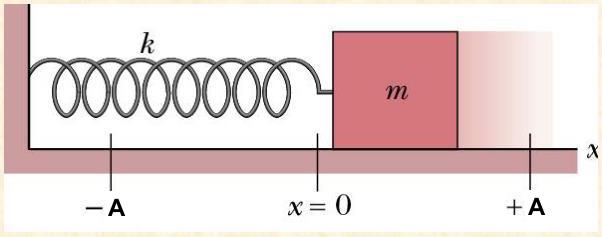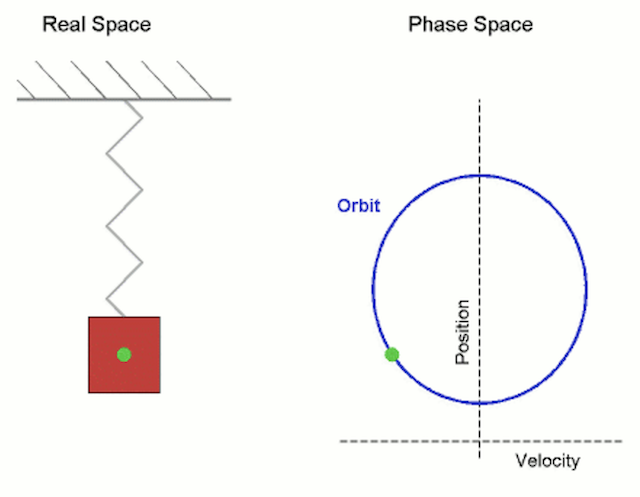Physics Notes - Herong's Tutorial Notes - v3.24, by Herong Yang
Hamiltonian on Simple Harmonic Motion
This section provides an example of calculating the Hamiltonian on a mechanical system of an single object in simple harmonic motion and applying the Law of Conservation of Energy.
What Is Simple Harmonic Motion? Simple Harmonic Motion is a periodic motion where the restoring force on the moving object is directly proportional to the magnitude of the object's displacement and acts towards the object's equilibrium position.
Let's first consider a mass on a spring moving horizontally on a frictionless surface as an example of Simple Harmonic Motion. The object's kinetic energy, T, and potential energy, V, can be expressed as:
T = m*v*v/2 # m is the mass of the object # v is the velocity of the object V = k*x**2/2 # k is the spring constant # x is object's displacement from the equilibrium position
So the Hamiltonian, H, of the free fall motion system can be expressed as:
H = T + V or: H = m*v*v/2 + k*x**2/2
Since this simple harmonic motion can be considered as an isolated conservative system, we can apply the Law of Conservation of Energy:
H = constant
or:
m*v*v/2 + k*x**2/2 = constant
or:
d(m*v*v/2)/dt + d(k*x**2/2)/dt = 0
# Since d(constant)/dt = 0
The last equation can be simplified as:
d(m*v*v/2)/dt + d(m*k*x)/dt = 0 m*v*dv/dt + k*x*dx/dt = 0 # The chain rule for derivatives applied m*v*a + k*x*v = 0 # a = dv/dt, is the acceleration of the object # v = dx/dt, is the velocity of the object m*a + k*x = 0 m*a = -k*x (H.6) # Cancel out v from the equation
Cool. Equation H.6 matches perfectly with Newton's second law of motion:
F = m*a (H.5) # Newton's second law of motion -k*x = m*a # Hooke's law, F = -k*x, applied. m*a = -k*x (H.6) # Moving terms around
With equation H.6, we can figure out the position x, the velocity v, and the acceleration a, as functions of time t. This is done by introducing some other constants:
x(t) = A* cos(w*t - u) v(t) = -A*w* sin(w*t - u) a(t) = -A*w*w*cos(w*t - u) # A is the amplitude (maximum displacement) # w = sqrt(k/m), is the angular frequency # u is the initial phase
The following picture illustrates an object on a spring moving horizontally (source: slideserver.com):

By the way, calculating Hamiltonian and applying the Law of Conservation of Energy to an object on a spring moving vertically results the same equation. The only difference is that the object's displacement, x, is pointing vertically.
m*a = -k*x (H.6)
The following picture illustrates an object on a spring moving vertically (source: wikipedia.org):

Table of Contents
Introduction of Frame of Reference
Introduction of Special Relativity
Time Dilation in Special Relativity
Length Contraction in Special Relativity
The Relativity of Simultaneity
Minkowski Spacetime and Diagrams
Hamiltonian on Free Fall Motion
►Hamiltonian on Simple Harmonic Motion
Hamiltonian on Simple Pendulum Motion
Relation of Momentum and Hamiltonian
Hamiltonian in Cartesian Coordinates
Relation of Momentum and Potential Energy
Hamilton Equations in Cartesian Coordinates
Introduction of Generalized Coordinates